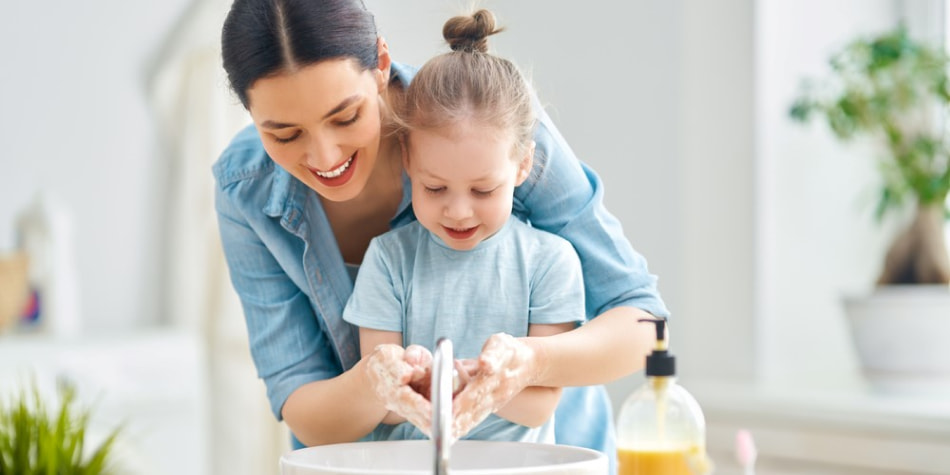
Learning and practicing healthy habits for kids, such as hand-washing, can help them stay safe as they go back-to-school.
As kids return to school this fall, they might have some concerns. After more than a year in the thick of COVID-19, experts say it's normal for kids to be nervous about in-person classes, just as many adults are anxious about in-person work.
As a parent, you can help by reminding children of the many things they can do to keep themselves and their classmates safe. Learning and practicing a few healthy habits for kids in these times of caution is a great way for them to feel more in control in a post-pandemic world.
Some habits that are already second nature to adults, such as wearing masks or washing hands, may be foreign to kids who have mostly stayed at home for the past year. Consider giving your child a refresher on how they can remain safe and healthy in the world outside with the following guidance.
1. Wash hands regularly
Washing your hands is one of the best ways to prevent sickness, according to the Centers for Disease Control and Prevention (CDC). While most kids likely know to wash their hands, they may not know how to do so correctly or how long to wash.
Help your youngsters create a back-to-school handwashing routine by encouraging trips to the sink before meals and after bathroom breaks, playtime and recess. For the best protection, have them scrub vigorously with soap and water for about 20 seconds. Sing a simple tune together twice, such as the happy birthday song, to help them remember how long to wash.
If there's no sink nearby, hand sanitizer will do. Just make sure it's at least 60% alcohol and that your kids let it dry fully after applying it to their hands.
2. Cover sneezes and coughs
Ideally, all kids should have a tissue available for when they sneeze or cough. If these are allowed, send travel-size tissue packs with your kids so that they always have one ready in their backpack or locker. And no reusing — remind them to throw away the tissue after each wipe.
If they don't have a tissue handy, sneezing or coughing into their elbow is acceptable, but only as a last resort. Have kids watch this video from the CDC to learn more.
3. Avoid sharing foods or drinks
While it was once fun to trade lunchbox snacks in the cafeteria, it's not a good idea to share food or drink in the current setting. Instead, if your child wants something that someone else brings to school, ask them what it is, and aim to pack something similar so that they don't miss out.
4. Follow instructions on social distancing and mask-wearing
Safety precautions can vary between schools or districts, so make sure your family understands the rules in your area before school starts. If your child will be wearing a mask, help them practice putting it on and taking it off, and remind them of the proper fit so that the mask covers their mouth and nose.
Social distancing may also play a role in some classes, so help kids understand situational awareness by doing "airplane hands," with their arms spread out to either side to indicate their personal space. Thanks to practices like this, 916 childcare centers experienced infection rates of just 0.16% last year, according to one study of more than 20,000 children.
5. Stay home when feeling sick
Pandemic or not, if your child feels sick, it's probably best for them to stay home, and parents should take extra care to ensure that their kids feel well before school every morning to prevent the spread of COVID-19. Children can do their part by telling parents about any symptoms they experience, particularly:
- Fever
- Sore throat
- Trouble breathing
- Coughing
- Throwing up
- Diarrhea
- Headache
If your child has any of those symptoms, the CDC recommends they stay home and get tested for COVID-19 and that you notify the school to let them know.
6. Stay hydrated and eat healthily
People who eat nutritious foods and remain hydrated tend to have stronger immune systems, which can help fight off infections like the flu, COVID-19 and other illnesses. So pack lunchboxes with whole grains, fruits, vegetables and lean proteins, and encourage children to snack wisely.
Remind your kids to drink water, as staying hydrated can help nutrients move more efficiently through the body. Let them pick out and decorate a reusable water bottle with fun stickers, and set a goal with them to drink 4 to 8 cups of water daily, depending on their age.
Get ready, but stay patient
As you help your child prepare for the changes ahead, be patient with them and with current circumstances. Encourage them to practice the healthy habits for kids detailed above, and acknowledge any anxieties, such as fear of germs, that may come with them.
Most importantly, ask your children questions and have open conversations with them. What makes you excited about going back to school? What makes you nervous? What can you do to feel better? After all, the transition from virtual learning to in-person classes may be long-awaited, but it will likely be challenging for some kids and families.
Take your cues from your youngster's feelings and fears, and give them the support they need to feel ready for their big day back.
$webqFacilityNumber
Need a Physician?